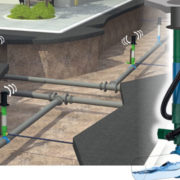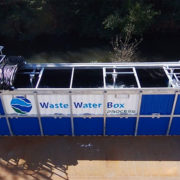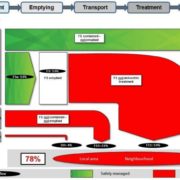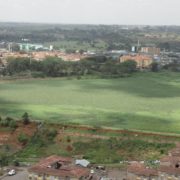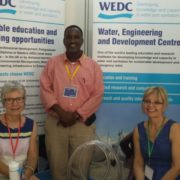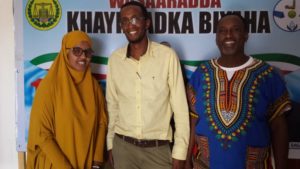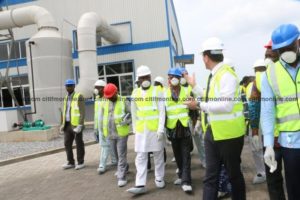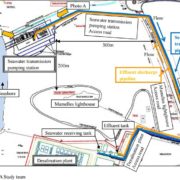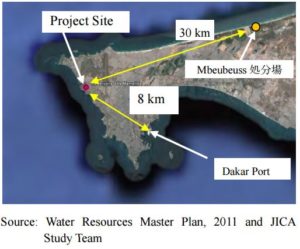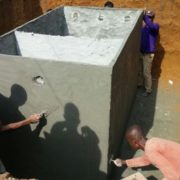The EAR Technology
The EAR Technology developed by the Sainte Lizaigne company of the CLAIRE Group is one of the 5 technologies presented at the innovation workshop organized in July 2017 in Accra. This is an initiative of the Isle Utilities organization. This workshop took place as a side event of the sessions of the 77th Scientific and Technical Council of AfWA held from July 17 to 21, 2017 in the Ghanaian capital.
The Isle Utilities organization presented 5 technologies to the thirty or so representatives of water utilities, including the “Ear” active connection, an acoustic listening device developed by Sainte-Lizaigne. This is part of the process of setting up a technological innovation platform for the benefit of water utilities in sub-Saharan Africa. Funded by the International Finance Corporation and The Global Innovation Fund GIF, this technology platform project is implemented in partnership with the African Water Association.
Marc Cormery, Export Manager of the Sainte-Lizaigne company, presented the EAR solution at this workshop. Sainte-Lizaigne’s EAR solution (expertise in the field of drinking water connections), developed in partnership with SebaKMT (expertise in the field of leak detection), is a permanent monitoring system for leak detection on HDPE/PVC networks (mainly present in Africa), but also for pipes of any diameter and material.
This is an active connection that is an integral part of the network heritage and, in addition to its opening/closing function, ensures permanent monitoring of the network by listening. The connections can thus be used as network listening points and form a strategic network.
Installed as a fixed prelocator on the network, the EAR solution allows precise listening because the hydrophone sensor is positioned in the water column and acquires the sounds directly: the listening is of very good quality, whatever the nature of the pipe and its diameter, and the surrounding noise minimized. Data collection is carried out by two methods: patrol mode or network. The correlation will then specify the exact location of the leak. As a permanent monitoring device, the EAR connection detects a leak at an early stage, improves response time and optimizes operating costs (reduced on-call time).
The EAR solution has already proven its worth. For example, it has made it possible to reduce water losses by 193,000 m3 in one year in a community of more than 110,000 subscribers (daily water consumption of 50,000 m3, 1,500 km of pipes) and a potential yield gain of 12 points.
The EAR system consists of:
– An intake valve with an integrated hydrophone sensor;
– A radio transmitter (located under the key-operated mouth or transferred to the counting station in a bollard or manhole) to record data, diagnose the problem;
– connectivity and accessories for integration. It can be installed on new or existing networks.
Sainte-Lizaigne is the specialist in solutions for connection to the metering environment for drinking water networks and offers systems for network control. The company employs 115 people and had a turnover of more than 28M€ in 2016. It designs, manufactures and sells water systems in France and abroad for water network operations. Sainte-Lizaigne’s customers include the main water distribution groups (Veolia, SAUR, Suez-Lyonnaise des Eaux, etc.), networks of distributors and wholesaler partners and local authorities. www.sainte-lizaigne.com
La Technologie EAR
La Technologie EAR développée par l’entreprise Sainte Lizaigne du Groupe CLAIRE fait partie des 5 technologie présentées à l’occasion de l’atelier d’innovation organisé en juillet 2017 à Accra. Il s’agit d’une initiative de l’organisation Isle Utilities. Cet atelier s’est déroulé en marges des Travaux du 77ème Conseil scientifique et Technique de l’AAE tenu du 17 au 21 juillet 2017 à dans la capitale ghanéenne.
La structure Isle Utilities a présenté 5 technologies à la trentaine de représentants des sociétés d’eau parmi lesquelles le branchement actif « Ear » un dispositif d’écoute acoustique développé par la société Sainte-Lizaigne. Ceci dans le cadre du processus de mise en place d’une plateforme d’innovation technologique au profit des sociétés d’eau d’Afrique Subsaharienne. Financé par la Société Financière Internationale et ‘’The Global Innovation Fund GIF’’, ce projet de plateforme technologique est mis en œuvre en partenariat avec l’Association Africaine de l’Eau.
C’est donc à l’occasion de cet atelier que Marc Cormery, Responsable Export de la structure ‘Sainte-Lizaigne’ a présenté la solution ‘’EAR’’.
La solution EAR de Sainte-Lizaigne (expertise dans le domaine du branchement d’eau potable), développée en partenariat avec SebaKMT (expertise dans le domaine de la recherche de fuite), est un système d’écoute permanent pour la détection de fuites sur les réseaux en PEHD/PVC (réseaux majoritairement présents en Afrique), mais aussi pour les conduites de tout diamètre et tout matériau. Il s’agit d’un branchement actif faisant partie intégrante du patrimoine réseau qui permet, en plus de sa fonction d’ouverture/fermeture, d’assurer une surveillance permanente du réseau par l’écoute. Les branchements peuvent ainsi être utilisés comme points d’écoute du réseau et former un maillage stratégique.
Installée en fixe en tant que prélocalisateur sur le réseau, la solution EAR permet une écoute précise car le capteur hydrophone est positionné dans la colonne d’eau et acquiert directement les bruits : l’écoute est de très bonne qualité, quels que soient la nature de la canalisation et son diamètre, et les bruits environnants minimisés. La collecte des données se réalise par deux méthodes : mode patrouille ou network. La corrélation précisera ensuite l’endroit exact de la fuite.
En tant que dispositif de surveillance permanente, le branchement EAR détecte de façon précoce une fuite, permet de gagner en réactivité d’intervention et d’optimiser les coûts d’exploitation (durée d’astreinte réduite).
La solution EAR a déjà fait ses preuves. Elle a permis par exemple une réduction de 193 000 m3 des pertes d’eau en 1 an dans une communauté d’agglomération de plus de 110 000 abonnés (consommation d’eau journalière de 50 000 m3, 1 500 km de canalisations) et un gain potentiel de rendement de 12 points.
Le système EAR se compose :
– d’un robinet de prise en charge intégrant un capteur hydrophone
– d’un émetteur radio (positionné sous la bouche à clé ou reporté au poste de comptage dans une borne ou un regard) permettant l’enregistrement des données, le diagnostic
– de la connectivité et des accessoires permettant l’intégration Il peut être installé sur les réseaux neufs ou existants.
Sainte-Lizaigne est le spécialiste des solutions du branchement à l’environnement de comptage pour les réseaux d’eau potable et propose des systèmes pour le pilotage de réseau. La société emploie 115 personnes et a réalisé un chiffre d’affaires de plus de 28M€ en 2016. Elle conçoit, fabrique en France et commercialise en France et à l’international pour les exploitations des réseaux d’eau. Sainte-Lizaigne compte parmi ses clients les principaux groupes de distribution d’eau (Veolia, SAUR, Suez-Lyonnaise des Eaux…), des réseaux de distributeurs et grossistes partenaires et les collectivités locales. www.sainte-lizaigne.com

